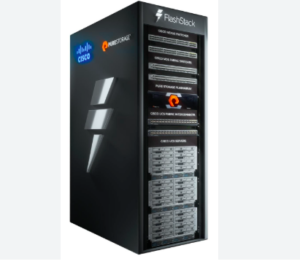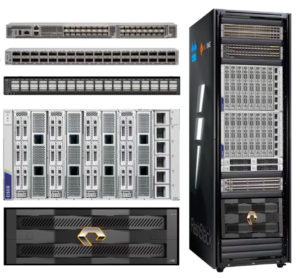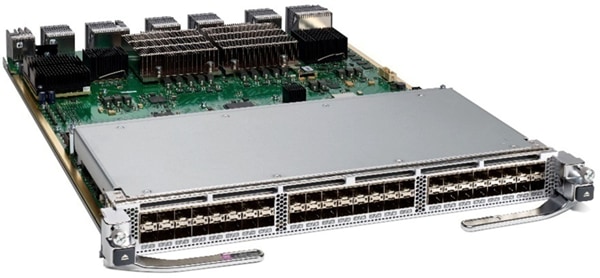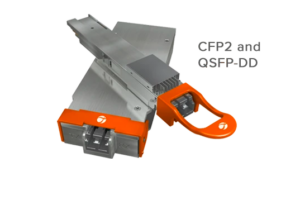Cisco MDS 9700 48-Port 32-Gbps Fibre Channel Switching Module
The Cisco® MDS 9700 48-Port 32-Gbps Fibre Channel Switching Module (Figure 1) delivers predictable performance, scalability, and innovative features to support private and virtualized data centers. With industry-leading 768 line-rate 32-Gbps Fibre Channel ports per director, the 32-Gbps 48-port Fibre Channel switching module meets the high-performance needs for flash-memory and Non-Volatile Memory Express (NVMe) over Fibre Channel workloads. It offers innovative services including virtual machine awareness, on-board Fibre Channel analytics engine, E-port and F-port diagnostics, integrated VSANs, Inter-VSAN Routing (IVR), and port channels. It delivers full-duplex aggregate performance of 1536 Gbps, making it well suited for high-speed 32-Gbps storage subsystems, 32-Gbps Inter-Switch Links (ISLs), high-performance virtualized servers, and all-flash and NVMe arrays.
The MDS 9700 48-Port 32-Gbps Fibre Channel Switching Module enables administrators to scale and consolidate SAN deployments with fewer hardware components. Your SAN administrators can consolidate workloads from hundreds of high-performance virtual machines and scale them with incremental updates as your SAN grows while protecting your existing investment.
This switching module ships with a built-in analytics engine. The engine can analyze real-time Fibre Channel exchanges and report on various metrics in detail, enabling comprehensive and timely monitoring of any potential performance problems among SAN edge devices. The on-board Network Processing Unit (NPU) in the module allows I/O-level metrics to be computed at every switch. The NPU can monitor all flows on all ports at line rate. The NPU examines every exchange passing through the 32-Gbps Application-Specific Integrated Circuit (ASIC) to capture flow metrics such as exchange completion time, maximum number of outstanding exchanges, data access latency, read and write I/O Operations Per Second (IOPS), throughput, Logical Unit Number (LUN) access pattern (sequential or random), and I/O block sizes.
The switching module is hot swappable and compatible with 4-, 8-, 16-, and 32-Gbps Fibre Channel interfaces. This module also supports hot-swappable Enhanced Small Form-Factor Pluggable (SFP+) transceivers. Individual ports can be configured with Cisco 32-, 16-, and 8-Gbps SFP+ transceivers. Each port supports 500 buffer credits for exceptional extensibility without the need for additional licenses. With the Cisco Enterprise Package license, up to 8191 buffer credits can be allocated to an individual port, enabling full link bandwidth over long distances with no degradation in link utilization.
The 32-Gbps Fibre Channel switching module also provides existing features such as predictable performance, high availability, advanced traffic management capabilities, integrated VSAN and IVR, resilient high-performance ISLs, hardware-assisted slow-drain support, comprehensive security frameworks, fault detection and isolation of errored packets, and sophisticated diagnostics.

 Main features
Main features
The Cisco MDS 9700 48-Port 32-Gbps Fibre Channel Switching Module offers the following main features:
● Outstanding SAN performance: The combination of the 32-Gbps Fibre Channel switching module and Fabric-1 crossbar switching modules enables up to 1.5 Terabits per second (Tbps) of Fibre Channel throughput between the modules in each direction for each payload slot in the Cisco MDS 9700 Series Multilayer Directors. The MDS 9700 Series architecture, which is based on central arbitration and a crossbar fabric, provides 32-Gbps line-rate, nonblocking, predictable performance across all traffic conditions for every port in the chassis.
● High availability: The MDS 9700 Series directors provide outstanding availability and reliability. They are the industry’s first director-class switches considered to support mission-critical workloads because they enable redundancy on all major components, including the fabric card. They also provide grid redundancy on the power supply and 1+1 redundant supervisors. Users can add a fabric card to enable N+1 fabric redundancy at 16-Gbps Fibre Channel speeds.
● Industry-leading scalability: The MDS 9700 Series directors combine industry-leading scalability with performance to meet the needs of even the largest data center storage environments. The Cisco MDS 9718 Multilayer Director supports up to 48 Tbps of Fibre Channel system bandwidth and 768 2-, 4-, 8-, 16-, and 32-Gbps full line-rate autosensing Fibre Channel ports in a single chassis. The Cisco MDS 9710 Multilayer Director supports up to 24 Tbps of Fibre Channel system bandwidth and up to 384 2-, 4-, 8-, 16-, and 32-Gbps full line-rate autosensing Fibre Channel ports in a single chassis. The smaller Cisco MDS 9706 Multilayer Director supports up to 12 Tbps of Fibre Channel system bandwidth and 192 2-, 4-, 8-, 16-, and 32-Gbps full line-rate autosensing Fibre Channel ports in a single chassis. The MDS 9700 Series directors can support both the Cisco MDS 9700 48-Port 16-Gbps Fibre Channel Switching Module and the Cisco MDS 9700 48-Port 32-Gbps Fibre Channel Switching Module in the same chassis, providing compatibility with the customer’s existing system.
ntelligent network services: VSAN technology, Access Control Lists (ACLs) for hardware-based intelligent frame processing, and fabric wide Quality of Service (QoS) enable migration from SAN islands to enterprise wide storage networks.
● Fibre Channel Redirect (FC-Redirect): FC-Redirect infrastructure provides the capability to redirect a flow to a specific service engine in the fabric to provide intelligent services such as Cisco Data Mobility Manager and Cisco MDS 9000 I/O Accelerator.
● Integrated hardware-based VSANs and IVR: VSANs are integrated into port-level hardware so that any port in a system or fabric can be assigned to any VSAN. The IVR provides line-rate routing between any ports in a system or fabric without the need for external routing appliances.
● Intelligent storage services: The MDS 9700 Series directors support intelligent service capabilities on other Cisco MDS 9000 Family switches to provide services such as acceleration of storage applications for data replication and backup.
● Smart Zoning: When the Smart Zoning feature is enabled, MDS 9700 Series fabrics provision the hardware ACL entries, specified by the zone set, more efficiently. This feature helps prevent superfluous entries that may allow servers (initiators) to talk to other servers or allow storage devices (targets) to talk to other storage devices. This feature makes feasible larger zones with multiple initiators and multiple targets without excessive consumption of hardware resources. Smart Zones can correspond to applications, application clusters, hypervisor clusters, and other data center entities, saving the time that administrators previously spent creating many small zones and enabling automation of zoning tasks.
● Virtual machine transparency: The MDS 9700 Series provides deterministic hardware performance and a comprehensive feature set that allows virtual machines to have the same SAN attributes as a physical server. On a per-virtual machine basis, Cisco NX-OS Software offers VSANs, QoS policies, access control, performance monitoring, and data protection to promote the scalability and mobility of virtual machines. Cisco Prime™ Data Center Network Manager (DCNM) enables rapid troubleshooting in mission-critical virtualized environments by providing end-to-end visibility from the virtual machine to storage with resource allocation, performance measurements, and predictions available on a per-virtual machine basis.
● Comprehensive security: The MDS 9700 Series devices supports services including VSANs, hardware-enforced zoning, ACLs, per-VSAN Role-Based Access Control (RBAC), and Cisco TrustSec® Fibre Channel link encryption. The comprehensive security framework consists of RADIUS and TACACS+, Fibre Channel Security Protocol (FC-SP), Secure File Transfer Protocol (SFTP), Secure Shell (SSH) Protocol, and Simple Network Management Protocol Version 3 (SNMPv3). The Cisco TrustSec Fibre Channel link encryption delivers transparent, hardware-based 32-Gbps line-rate Advanced Encryption Standard (AES) 128-bit encryption of Fibre Channel data on 32-Gbps Fibre Channel switching modules.
Resilient high-performance ISLs: The MDS 9700 Series 32-Gbps Fibre Channel switching modules support high-performance ISLs consisting of 32-Gbps secure Fibre Channel. Fibre Channel switching modules also support port-channel technology for additional scalability and resilience. Administrators can group up to 16 links spanning any port on any module in a chassis into a logical link. Administrators can also allocate up to 8191 buffer-to-buffer credits to a single Fibre Channel port, providing industry-leading extension of storage networks to up to 4000 kilometers at 4 Gbps, 2000 kilometers at 8 Gbps, 1000 kilometers at 16 Gbps, and 500 kilometers at 32 Gbps, while maintaining full link utilization. The MDS 9700 Series switch architecture helps ensure that frames are never reordered within a switch, leading to optimal application performance because end devices never have to use resources to reorder the frames.
● Sophisticated diagnostics: The MDS 9700 48-Port 32-Gbps Fibre Channel Switching Module provides intelligent diagnostics, protocol decoding, E-port diagnostics, and network analysis tools along with an integrated Cisco Call Home capability for greater reliability, faster problem resolution, and reduced service costs.
● Compatibility: The MDS 9700 48-Port 32-Gbps Fibre Channel Switching Module can co-exist with previous-generation supported modules on the MDS 9700 Series director.
● Investment protection: The MDS 9700 48-Port 32-Gbps Fibre Channel Switching Module can easily be inserted into existing MDS 9700 Series directors without any impact on operations. Existing 16-Gbps customers can transparently move to 32-Gbps speeds without the need for a major equipment upgrade. Cisco continues its tradition of providing multiple generations of speeds (16- and 10-Gbp Fibre Channel over Ethernet [FCoE], 40-Gbps FCoE, and now 32-Gbps Fibre Channel) on the same chassis, providing customers with exceptional investment protection for their existing systems.
Main benefits

The Cisco MDS 9700 48-Port 32-Gbps Fibre Channel Switching Module offers the following main benefits:
● Lower Total Cost of Ownership (TCO) with SAN consolidation: With the exponential growth of data in today’s business environment, organizations need to deploy large-scale SANs in the most efficient and cost-effective ways. To meet scalability requirements while managing TCO, the MDS 9700 Series directors offer the following.
◦ Industry-leading port density of line-rate 32-Gbps Fibre Channel ports per chassis.
◦ 1.5-Tbps Fibre Channel performance per slot.
◦ Up to 48-Tbps front-panel Fibre Channel line-rate nonblocking system-level switching.
◦ Exceptional capabilities with intelligent fabric services.
◦ VSANs for consolidating individual physical SAN islands while maintaining logical boundaries.
◦ IVR for sharing resources across VSANs.
◦ Built-in network processing unit for inline analytics.
These features enable the consolidation of an organization’s data assets into fewer, larger, and more manageable SANs, thus reducing the hardware footprint and associated capital and operating expenses.
● Enterprise-class availability: The MDS 9700 Series was specifically designed from the beginning for high-availability and mission-critical environments. Beyond meeting the basic requirements of nondisruptive software upgrades and redundancy of all critical hardware components, the MDS 9700 Series software architecture offers outstanding greater than five-nines availability.
● Virtual machine–aware SAN deployment: The growing adoption of server virtualization in data centers increases the number of hosts attached to the SAN, places higher workloads on the SAN, and requires more storage, thereby increasing the need for SAN services. The Cisco VMpath technology, part of Cisco Prime DCNM, provides end-to-end visibility from the virtual machines to the storage devices. Resource allocation, performance measurements, and predictions are available on a per-virtual machine basis to enable rapid troubleshooting in mission-critical virtualized environments.
● Advanced traffic management: The following advanced traffic management capabilities, integrated into every MDS 9700 48-Port 32-Gbps Fibre Channel Switching Module, simplify deployment and optimization of large-scale fabrics:
◦ The Virtual Output Queue (VOQ) helps ensure line-rate performance on each port, independent of traffic pattern, by eliminating head-of-line blocking.
◦ Up to 8191 buffer-to-buffer credits can be assigned to any individual port for optimal bandwidth utilization across distances.
◦ Port channels allow up to 16 physical ISLs to be aggregated into a single logical bundle, providing optimized bandwidth utilization across all links. The bundle can be a mix of any port from any module in the chassis. This approach helps ensures that the bundle can remain active even if a module fails.
◦ Fabric Shortest Path First (FSPF)-based multipathing provides the intelligence to load-balance across up to 16 equal-cost paths and dynamically reroute traffic if a switch fails.
◦ QoS helps manage bandwidth and control latency to prioritize critical traffic and is available on every port.
◦ The lossless networkwide in-order delivery guarantee helps ensure that frames are never reordered within a switch. This guarantee extends across the entire multiswitch fabric, assuming that the fabric is stable and no topology changes are made.
● Advanced diagnostics and troubleshooting tools: The MDS 9700 Series integrates proactive diagnostics, tools to verify connectivity and route latency and to capture and analyze traffic, thereby simplifying the management of large-scale storage networks. The power-on self-test (POST) and online diagnostics provide proactive health monitoring. Starting with Cisco MDS 9000 NX-OS Software Release 6.2, the powerful Cisco Generic Online Diagnostics (GOLD) framework replaces the Cisco Online Health Management System (OHMS) diagnostic framework on the new MDS 9700 Series Multilayer Director chassis. GOLD is a suite of diagnostic facilities that verify whether the hardware and internal data paths are operating as designed. Boot-time diagnostics, continuous monitoring, standby fabric loopback tests, and on-demand and scheduled tests are part of the GOLD feature set. This industry-leading diagnostics subsystem enables rapid fault isolation and continuous system monitoring, which are critical features in today’s continuously operating environments.
Integrated hardware functions support diagnostic capabilities such as Fibre Channel traceroute to identify the exact path and timing of flows, and Cisco Switched Port Analyzer (SPAN) and Remote SPAN (RSPAN) to intelligently capture network traffic. The captured Fibre Channel traffic can be analyzed with the embedded Cisco Fabric Analyzer. Comprehensive port-based and flow-based statistics enable sophisticated performance analysis and Service-Level Agreement (SLA) accounting.
● Comprehensive solution for robust security: Addressing the need for stringent security in storage networks, the MDS 9700 Series 32-Gbps Fibre Channel line card offers an extensive security framework to protect the highly sensitive data crossing today’s enterprise networks. The MDS 9700 Series employs intelligent packet inspection at the port level, including the application of ACLs for hardware enforcement of zones, VSANs, and advanced port security features. VSANs are used to achieve greater security and stability by providing complete isolation of devices that are connected to the same physical SAN. IVR enables controlled sharing of resources between VSANs.
In addition, FC-SP1 provides switch-to-switch and host-to-switch Diffie-Hellman Challenge Handshake Authentication Protocol (DH CHAP) authentication supporting RADIUS or TACACS+ to help ensure that only authorized devices access protected storage networks. Cisco TrustSec1 Fibre Channel link encryption, available on the MDS 9700 Series 32-Gbps modules, allows you to transparently encrypt ISLs at up to line-rate speeds, providing an additional layer of protection for traffic within and between data centers. The MDS 9700 Series supports a fabric binding feature that helps ensure that ISLs are enabled only between specified switches in the fabric binding configuration.
● Integrated mainframe support: The MDS 9700 Series is mainframe ready, with full support for IBM System z Fibre Connection (FICON) and Linux environments. The MDS 9700 Series supports transport of the FICON protocol in both cascaded and noncascaded fabrics. It also supports a mix of FICON and open-systems Fibre Channel Protocol (FCP) traffic on the same switch.





